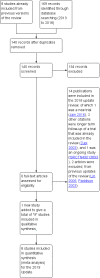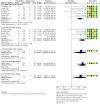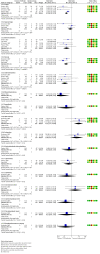Endometrial resection and ablation versus hysterectomy for heavy menstrual bleeding
- PMID: 31463964
- PMCID: PMC6713886
- DOI: 10.1002/14651858.CD000329.pub3
Endometrial resection and ablation versus hysterectomy for heavy menstrual bleeding
Update in
-
Endometrial resection and ablation versus hysterectomy for heavy menstrual bleeding.Cochrane Database Syst Rev. 2021 Feb 23;2(2):CD000329. doi: 10.1002/14651858.CD000329.pub4. Cochrane Database Syst Rev. 2021. PMID: 33619722 Free PMC article.
Abstract
Background: Heavy menstrual bleeding (HMB) is an important cause of ill health in women of reproductive age, causing them physical problems, social disruption and reducing their quality of life. Medical therapy has traditionally been first-line therapy. Surgical treatment of HMB often follows failed or ineffective medical therapy. The definitive treatment is hysterectomy, but this is a major surgical procedure with significant physical and emotional complications, as well as social and economic costs. Less invasive surgical techniques, such as endometrial resection and ablation, have been developed with the purpose of improving menstrual symptoms by removing or ablating the entire thickness of the endometrium.
Objectives: To compare the effectiveness, acceptability and safety of techniques of endometrial destruction by any means versus hysterectomy by any means for the treatment of heavy menstrual bleeding.
Search methods: Electronic searches for relevant randomised controlled trials (RCTs) targeted-but were not limited to-the following: the Cochrane Gynaecology and Fertility Group's specialised register, CENTRAL via the Cochrane Register of Studies Online (CRSO), MEDLINE, Embase, PsycINFO, and the ongoing trial registries. We made attempts to identify trials by examining citation lists of review articles and guidelines and by performing handsearching. Searches were performed in 1999, 2007, 2008, 2013 and on 10 December 2018.
Selection criteria: Any RCTs that compared techniques of endometrial resection or ablation (by any means) with hysterectomy (by any technique) for the treatment of heavy menstrual bleeding in premenopausal women.
Data collection and analysis: Two review authors independently selected trials for inclusion, extracted data and assessed trials for risk of bias.
Main results: We identified nine RCTs that fulfilled our inclusion criteria for this review. For two trials, the review authors identified multiple publications that assessed different outcomes at different postoperative time points for the same women. No included trials used third generation techniques.Clinical measures of improved bleeding symptoms and satisfaction rates were observed in women who had undergone hysterectomy compared to endometrial ablation. A slightly lower proportion of women who underwent endometrial ablation perceived improvement in bleeding symptoms at one year (risk ratio (RR) 0.89, 95% confidence interval (CI) 0.85 to 0.93; 4 studies, 650 women, I² = 31%; low-quality evidence), at two years (RR 0.92, 95% CI 0.86 to 0.99; 2 studies, 292 women, I² = 53%) and at four years (RR 0.93, 95% CI 0.88 to 0.99; 2 studies, 237 women, I² = 79%). Women in the endometrial ablation group also showed improvement in pictorial blood loss assessment chart compared to their baseline (PBAC) score at one year (MD 24.40, 95% CI 16.01 to 32.79; 1 study, 68 women; moderate-quality evidence) and at two years (MD 44.00, 95% CI 36.09 to 51.91; 1 study, 68 women). Repeat surgery resulting from failure of the initial treatment was more likely to be needed after endometrial ablation than after hysterectomy at one year (RR 16.17, 95% CI 5.53 to 47.24; 927 women; 7 studies; I2 = 0%), at two years (RR 34.06, 95% CI 9.86 to 117.65; 930 women; 6 studies; I2 = 0%), at three years (RR 22.90, 95% CI 1.42 to 370.26; 172 women; 1 study) and at four years (RR 36.32, 95% CI 5.09 to 259.21;197 women; 1 study). The satisfaction rate was lower amongst those who had endometrial ablation at two years after surgery (RR 0.87, 95% CI 0.80 to 0.95; 4 studies, 567 women, I² = 0%; moderate-quality evidence), and no evidence of clear difference was reported between post-treatment satisfaction rates in groups at other follow-up times (1 and 4 years).Most adverse events, both major and minor, were more likely after hysterectomy during hospital stay. Women who had an endometrial ablation were less likely to experience sepsis (RR 0.19, 95% CI 0.12 to 0.31; participants = 621; studies = 4; I2 = 62%), blood transfusion (RR 0.20, 95% CI 0.07 to 0.59; 791 women; 5 studies; I2 = 0%), pyrexia (RR 0.17, 95% CI 0.09 to 0.35; 605 women; 3 studies; I2 = 66%), vault haematoma (RR 0.11, 95% CI 0.04 to 0.34; 858 women; 5 studies; I2 = 0%) and wound haematoma (RR 0.03, 95% CI 0.00 to 0.53; 202 women; 1 study) before hospital discharge. After discharge from hospital, the only difference that was reported for this group was a higher rate of infection (RR 0.27, 95% CI 0.13 to 0.58; 172 women; 1 study).Recovery time was shorter in the endometrial ablation group, considering hospital stay, time to return to normal activities and time to return to work; we did not, however, pool these data owing to high heterogeneity. Some outcomes (such as a woman's perception of bleeding and proportion of women requiring further surgery for HMB), generated a low GRADE score, suggesting that further research in these areas is likely to change the estimates.
Authors' conclusions: Endometrial resection and ablation offers an alternative to hysterectomy as a surgical treatment for heavy menstrual bleeding. Both procedures are effective, and satisfaction rates are high. Although hysterectomy offers permanent and immediate relief from heavy menstrual bleeding, it is associated with a longer operating time and recovery period. Hysterectomy also has higher rates of postoperative complications such as sepsis, blood transfusion and haematoma (vault and wound). The initial cost of endometrial destruction is lower than that of hysterectomy but, because retreatment is often necessary, the cost difference narrows over time.
Conflict of interest statement
No conflicts of interest were reported by RF, MB, AL, or CF.
Figures





















Update of
-
Endometrial resection and ablation versus hysterectomy for heavy menstrual bleeding.Cochrane Database Syst Rev. 2013 Nov 29;(11):CD000329. doi: 10.1002/14651858.CD000329.pub2. Cochrane Database Syst Rev. 2013. Update in: Cochrane Database Syst Rev. 2019 Aug 29;8:CD000329. doi: 10.1002/14651858.CD000329.pub3. PMID: 24288154 Updated.
References
References to studies included in this review
Crosignani 1997 {published data only}
-
- Crosignani PG, Vercellini P, Apolone G, Giorgi O, Cortesi I, Meschia M. Endometrial resection versus vaginal hysterectomy for menorrhagia: long‐term clinical and quality‐of‐life outcomes. American Journal of Obstetrics and Gynecology 1997;177(1):95‐101. - PubMed
Dickersin 2007 {published data only}
-
- Dickersin K, Munro M, Langenberg P, Scherer R, Frick KD, Weber AM, et al. Surgical treatments outcomes project for dysfunctional uterine bleeding (STOP‐DUB): design and methods. Controlled Clinical Trials 2003;24(5):591‐609. - PubMed
-
- Dickersin K, Munro MG, Clark M, Langenberg P, Scherer R, Frick K, et al. Hysterectomy compared with endometrial ablation for dysfunctional uterine bleeding. Obstetrics and Gynecology 2007;110(6):1279‐89. - PubMed
-
- Munro M, Dickerson K, Clark M, Langenberg P, Scherer R, Frick K. The Surgical Treatments Outcomes Project for Dysfunctional Uterine Bleeding: summary of an Agency for Health Research and Quality‐sponsored randomized trial of endometrial ablation versus hysterectomy for women with heavy menstrual bleeding. Menopause 2011;18(4):451‐8. - PubMed
Dwyer 1993 {published data only}
-
- Dwyer N, Hutton J, Stirrat GM. Randomised controlled trial comparing endometrial resection with abdominal hysterectomy for the surgical treatment of menorrhagia. British Journal of Obstetrics and Gynaecology 1993;100(3):237‐43. - PubMed
-
- Sculpher M. A cost‐utility analysis of abdominal hysterectomy versus transcervical endometrial resection for the surgical treatment of menorrhagia. International Journal of Technology Assessment in Health Care 1998;14(2):302‐19. - PubMed
-
- Sculpher MJ, Bryan S, Dwyer N, Hutton J, Stirrat GM. An economic evaluation of transcervical endometrial resection versus abdominal hysterectomy for the treatment of menorrhagia. British Journal of Obstetrics and Gynaecology 1993;100(3):244‐52. - PubMed
-
- Sculpher MJ, Dwyer N, Byford S, Stirrat GM. Randomised trial comparing hysterectomy and transcervical endometrial resection: effect on health related quality of life and costs two years after surgery. British Journal of Obstetrics and Gynaecology 1996;103(2):142‐9. - PubMed
Gannon 1991 {published data only}
Jain 2016 {published data only}
-
- Jain P, Rajaram S, Gupta B, Goel N, Srivastava H. Randomized controlled trial of thermal balloon ablation versus vaginal hysterectomy for leiomyoma‐induced heavy menstrual bleeding. International Journal of Gynaecology and Obstetrics 2016;135(2):140‐4. [https://doi.org/10.1016/j.ijgo.2016.04.020] - PubMed
O'Connor 1997 {published data only}
-
- O'Connor H, Broadbent JA, Magos AL, McPherson K. Medical Research Council randomised trial of endometrial resection versus hysterectomy in management of menorrhagia. Lancet 1997;349(9056):897‐901. - PubMed
Pinion 1994 {published data only}
-
- Aberdeen Endometrial Ablation Trials Group. A randomised trial of endometrial ablation versus hysterectomy for the treatment of dysfunctional uterine bleeding: outcome at four years. British Journal of Obstetrics and Gynaecology 1999;106(4):360‐6. - PubMed
-
- Cameron IM, Mollison J, Pinion SB, Atherton‐Naji A, Buckingham K, Torgerson D. A cost comparison of hysterectomy and hysteroscopic surgery for the treatment of menorrhagia. European Journal of Obstetrics and Gynaecology 1996;70(1):87‐92. - PubMed
-
- Pinion SB, Parkin DE, Abramovich DR, Naji A, Alexander DA, Russell IT, et al. Randomised trial of hysterectomy, endometrial laser ablation, and transcervical endometrial resection for dysfunctional uterine bleeding. British Medical Journal (Clinical Research Ed.) 1994;309(6960):979‐83. - PMC - PubMed
Sesti 2011 {published data only}
-
- Sesti F, Ruggeri V, Pietropolli A, Piancatelli R, Piccione E. Thermal balloon ablation versus laparoscopic supracervical hysterectomy for the surgical treatment of heavy menstrual bleeding: a randomized study. Journal of Obstetrics and Gynaecology Research 2011;37(11):1650‐7. - PubMed
Zupi 2003 {published data only}
-
- Centini G, Lazzeri L, Finco A, Afors K, Zupi E. Quality of life and risk of reintervention comparing endometrial ablation and laparoscopic sutotal hysterectomy: A 15 years follow up study. Gynecological Surgery 2015;12(Suppl 1):S11.
-
- Zupi E, Centini G, Lazzeri L, Finco A, Exacoustos C, Afors, et al. Hysteroscopic endometrial resection versus laparoscopic supracervical hysterectomy for abnormal uterine bleeding: long term follow‐up of a prospective randomized trial. Journal of Minimally Invasive Gynecology 2015;22(5):841‐5. [DOI: 10.1016/j.jmig.2015.08.108] - DOI - PubMed
-
- Zupi E, Zullo F, Marconi D, Sbracia M, Pellicano M, Solima E, et al. Hysteroscopic endometrial resection versus laparoscopic supracervical hysterectomy for menorrhagia: a prospective randomized trial. American Journal of Obstetrics and Gynecology 2003;188(1):7‐12. - PubMed
References to studies excluded from this review
Lin 2006 {published data only}
-
- Lin H. Comparison between microwave endometrial ablation and total hysterectomy. Chinese Medical Journal 2006;119(14):1195‐7. - PubMed
Paddison 2003 {published data only}
-
- Paddison K. Menorrhagia: endometrial ablation or hysterectomy. Nursing Standard 2003;18(1):33‐7. - PubMed
References to ongoing studies
ISRCTN49013893 {published data only}
Additional references
Adelman 2014
Athanatos 2015
-
- Athanatos D, Pados G, Venetis CA, Stamatopoulos P, Rousso D, Tsolakidis D. Novasure impedance control system versus microwave endometrial ablation for the treatment of dysfunctional uterine bleeding: a double‐blind, randomized controlled trial. Clinical and Experimental Obstetrics & Gynecology 2015;42(3):347‐51. [PUBMED: 26152008] - PubMed
Bhattacharya 2011
-
- Bhattacharya S, Middleton L, Tsourapas A, Champaneria R, Daniels J, Roberts T, et al. Hysterectomy, endometrial ablation and Mirena for heavy menstrual bleeding: a systematic review of clinical effectiveness and cost‐effectiveness analysis. Health Technology Assessment April 2011; Vol. 19:1‐252. - PMC - PubMed
Bofill Rodriguez 2019
Bourdrez 2004
-
- Bourdrez P, Bongers MY, Mol BWJ. Treatment of dysfunctional uterine bleeding: patient preferences for endometrial ablation, a levonorgestrel‐releasing intrauterine device, or hysterectomy. Fertility and Sterility 2004;82(1):160‐6. - PubMed
Brazier 1993
-
- Brazier JE, Jones NMB, Kind P. Testing the validity of the Euroqol and comparing it with the SP36 health survey questionnaire. Quality of Life Research 1993;2(3):169‐80. - PubMed
Bridgman 1994
-
- Bridgman SA. Increasing operative rates for dysfunctional uterine bleeding after endometrial ablation (letter). Lancet 1994;344:893. - PubMed
Clegg 2007
-
- Clegg JP, Guest JF, Hurskainen R. Cost‐utility of levonorgestrel intrauterine system compared with hysterectomy and second generation endometrial ablative techniques in managing patients with menorrhagia in the UK. Current Medical Research and Opinion 2007;23(7):1673‐48. - PubMed
Cooper 2011
-
- Cooper K, Lee A, Chien P, Raja E, Timmaraju V, Bhattacharya S. Outcomes following hysterectomy or endometrial ablation for heavy menstrual bleeding: retrospective analysis of hospital episode statistics in Scotland. British Journal of Obstetrics and Gynaecology 2011;118(10):1171‐9. - PubMed
Coulter 1991
-
- Coulter A, Bradlow J, Agass M, Martin‐Bates C, Tullock A. Outcomes of referrals to gynaecology outpatient clinics for menstrual problems: an audit of general practice records. British Journal of Obstetrics and Gynaecology 1991;98(8):789‐96. - PubMed
Coulter 1994
-
- Coulter A. Trends in gynaecological surgery (letter). Lancet 1994;344:1367. - PubMed
EuroQol Group 1990
-
- EuroQol Group. EuroQol—a new facility for the measurement of health‐related quality of life. Health Policy (Amsterdam, Netherlands) 1990;16(3):199‐208. - PubMed
Fernandez 2011
-
- Fernandez H. Update on the management of menometrorrhagia: new surgical approaches. Gynecological Endocrinology 2011;Suppl 1:1131‐6. - PubMed
Garrat 1995
-
- Garrat AM, Torgerson DJ, Wyness J, Hall MH, Reid DM. Measuring sexual functioning in premenopausal women. British Journal of Obstetrics and Gynaecology 1995;102(4):311‐6. - PubMed
Garside 2004
-
- Garside R, Stein K, Wyatt K, et al. A cost‐utility analysis of microwave and thermal balloon endometrial ablation techniques for the treatment of heavy menstrual bleeding. British Journal of Obstetrics and Gynaecology 2004;111(10):1103‐14. - PubMed
GRADEpro GDT [Computer program]
-
- McMaster University (developed by Evidence Prime). GRADEpro GDT. Version accessed prior to 17 July 2019. Hamilton (ON): McMaster University (developed by Evidence Prime).
Higgins 2008
Higgins 2011
-
- Higgins JP, Green S, editor(s). Cochrane Handbook for Systematic Reviews of Interventions Version 5.1.0 (updated March 2011). The Cochrane Collaboration, 2011. Available from handbook.cochrane.org. Version 5.0.0. New York: John Wiley & Sons, 2011.
Kalampolas 2017
Kennedy 2002
-
- Kennedy ADM, Sculpher MJ, Coulter A, Dwyer N, Rees M, Abrams KR, et al. Effects of decision aids for menorrhagia on treatment choices, health outcomes and costs. JAMA 2002;288(21):2701‐8. - PubMed
Kumar 2016
Laberge 2016
-
- Laberge P, Leyland N, Murji A, Fortin C, Martyn P, Vilos G, et al. Endometrial ablation in the management of abnormal uterine bleeding. Journal d'Obstetrique et Gynecologie du Canada : JOGC [Journal of Obstetrics and Gynaecology Canada : JOGC] 2015;37(4):362‐79. [PUBMED: 26001691] - PubMed
Li 2012
-
- Li M, Han Y, Feng YC. Single‐port laparoscopic hysterectomy vs conventional laparoscopic hysterectomy: a prospective randomised trial. Journal of International Medical Research 2012;40(2):701‐8. - PubMed
Madhu 2009
Munro 2011
-
- Munro MG, Critchley HO, Broder MS, Fraser IS. FIGO classification system (PALM‐COEIN) for causes of abnormal uterine bleeding in nongravid women of reproductive age. International Journal of Gynaecology and Obstetrics 2011;113(1):3‐13. - PubMed
Nagele 1998
-
- Nagele F, Rubinger T, Magos A. Why do women choose endometrial ablation rather than hysterectomy?. Fertility and Sterility 1998;69(6):1063‐6. - PubMed
NICE 2007
-
- National Collaborating Centre for Women's and Children's Health. Heavy Menstrual Bleeding. London: RCOG Press, 2007. - PubMed
NICE 2018
-
- NICE guideline. Heavy menstrual bleeding: assessment and management. www.nice.org.uk/guidance/ng88 2018.
Overton 1997
-
- Overton C, Hargreaves J, Maresh M. A national survey of the complications of endometrial destruction for menstrual disorders: the MISTLETOE study. British Journal of Obstetrics and Gynaecology 1997;104(12):1351‐9. - PubMed
Reich 1989
-
- Reich H, DeCaprio J, McGlynn F. Laparoscopic hysterectomy. Journal of Gynaecological Surgery 1989;5:213.
Reid 2007
-
- Reid PC. Endometrial ablation in England—coming of age? An examination of hospital episode statistics 1989/1990 to 2004/2005. European Journal of Obstetrics and Gynecology 2007;135(2):191‐4. - PubMed
Roberts 2011
Rust 1986
-
- Rust J, Bennum I, Crowe M, Golombok S. The construction and validation of the Golombok Rust inventory of marital state. Sexual and Marital Therapy 1986;1:34‐40.
Sculpher 1998
-
- Sculpher M. The cost‐effectiveness of preference‐based treatment allocation: the case of hysterectomy versus endometrial resection in the treatment of menorrhagia. Health Economics 1998;7(2):129‐42. - PubMed
Sharp 2012
-
- Sharp HT. Endometrial ablation: postoperative complications. American Journal of Obstetrics and Gynecology 2012;207(4):242‐7. - PubMed
Vessey 1992
-
- Vessey M, Villard‐Mackintosh L, McPherson K, Coulter A, Yeates D. The epidemiology of hysterectomy: findings in a large cohort study. British Journal of Obstetrics and Gynaecology 1992;99(5):402‐7. - PubMed
Ware 1993
-
- Ware JE, Snow KK, Kosinski M, et al. SF‐36 Health survey: manual and interpretation guide. The Health Institute. Boston: New England Medical Centre, 1993.
Woolcock 2008
-
- Woolcock JG, Critchley HO, Munro MG, Broder MS, Fraser IS. Review of the confusion in current and historical terminology and definitions for disturbances in menstrual bleeding. Fertility and Sterility 2008;90(6):2269. - PubMed
You 2006
-
- You JH, Sahota DS, Yuen PM. A cost‐utility analysis of hysterectomy, endometrial resection and ablation and medical therapy for menorrhagia. Human Reproduction (Oxford, England) 2006;21(7):1878‐83. - PubMed
Zigmond 1983
-
- Zigmond AS, Snaith RP. The Hospital Anxiety and Depression Scale. Acta Psychiatrica Scandinavica 1983;67(6):361‐70. - PubMed
References to other published versions of this review
Cooke 1996
Lethaby 1999
Lethaby 2009
Publication types
MeSH terms
LinkOut - more resources
Full Text Sources

